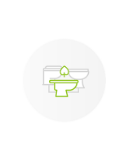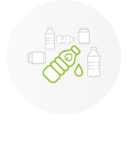Mobile Composting Toilet Management and Spill Containment Procedures
This is WCTNZ®'s official guide to mobile composting toilet management.
For more info, please refer to the additional literature of each specific composting system by the manufacturer.
In the context of RVs, there are 2 primary streams of waste - these are solids (feces) and urine - and they may or may not be both in one chamber. Additionally, depending on the toilet type, solids may be mixed with an organic substrate (bulking agent) to create composting conditions.
Most RV-compatible toilets are urine diversion types with a separate containment bottle for urine, which keeps it separate from the solids in the composting chamber. Urine diversion can also exist in the form of a urine tank rather than a bottle.
As with all waterless composting toilets, there is no water or blue chemical used, so no additional volume is added to the tankage/storage. This makes composting toilets advantageous, especially in the case of smaller vehicles.
Containment of solids often outlasts urine bottles, but may not outlast the berthing cycle of urine tanks.
Disposal of Urine
Urine can be disposed of at the dump station, at both bio-active (septic system with onsite disposal field) and holding tank type dump stations. This can be done by pouring out the contents of the urine container or from the urine tank with compliant connections.
Urine from a containment bottle can also be poured into public toilets encountered on the road. This can also be done with urine tanks as long as they have a built-in pump.
Spillage - urine is relatively safe if spilled, but it is not recommended for it to end up in waterways. If spillage takes place, the urine needs to be removed from the environment. This can be done with a wash-down procedure or with absorbent powder. If spillage occurs on soil, the urine is to be removed by wash-down only, provided the spillage zone is at least 20m away from rivers.
Disposal of Solids
Solid matter is to be stored in a vented locker onboard until a disposal location is available. Systems in which solids are blended with an organic substrate achieve an odourless compost, allowing for comfortable storage. Systems without the addition of organic substrate are more likely to have odour, so timely disposal is preferred.
Final disposal of solid matter can be done on private property by burial substrata, according to the Waterless Composting Toilets Standard.
If there is no private property available, solids can be disposed of at the dump station into either a holding tank or a bio-active tank (septic system with onsite disposal field). Waste disposal into the bio-active tank will aid overall decomposition in the tank. Organic materials from composting waste are similar to toilet tissue present in chem blue waste holding tanks, but are less fine by nature. Organic materials benefit carbonaceous bacteria in wastewater systems.
As a general rule, we do not recommend disposing of solids into septic tanks due to the following reasons:
- High solid volumes may affect an aerated wastewater system with bio-filters.
- If solid waste is contained inside compostable bags, the bags may impinge on the holding tank, septic truck pump system may fail due to the binding of the bag around the impeller.
Spillage - Spillage is unlikely to happen with biodegradable bags. If spillage does occur, one must wear PPE (a respiratory mask and gloves) and use a dust pan to return materials to a biodegradable bag. This is best done in low wind conditions. If done in high wind conditions, it is recommended that the waste is wetted first to minimise airborne particles.
All-in-one Systems Waste Disposal
For all-in-one systems (pees and poos stored together), disposal is to be done per the Disposal of Solids guidelines above. All-in-one systems require a leachate drain for excess liquids running off the compost, and this requires a blackwater tank, which can be emptied at the dump station.
Incinerating Toilet Waste Disposal
Incinerating toilet waste is best contained in an airtight container and disposed of via solid waste disposal (in the rubbish).
Private property disposal of ash adheres to composting toilet practices and should be buried in a dry soil zone. Another good, far-reaching and rural application is the addition of ash to the longdrop.
Ash can also be disposed of at dump stations, in a manner where the waste does not become airborne. Note, too much ash added to bio-active dump station (station breaking down waste/not purely for containment) can change the pH inside the tank and sterilise the decomposition process.
Spillage - relatively safe when spilled, as long as the system has achieved a total burn (i.e. there was no system failure). To err on the side of caution, safe disposal is required. Note, ash has an alkalizing effect in the environment, and should ideally not spread into water or repeatedly be spilled and left uncovered in the same land location. It should never be applied topically (sprinkled).
Note, although incinerating toilets aren't the same as composting toilets, they are dry toilets and are within the scope of alternative water-free toilets.
Public Dump Station Locations
See list of public dump station locations throughout New Zealand here.
Need help choosing a system? Call WCTNZ® on 0800 022 027 for free advice on system specification and setup. Advanced design consultancy services are also available.
Copyright © 2025 Waterless Composting Toilets NZ Limited (WCTNZ®). All rights reserved.
This content has been reviewed and approved by Dylan Timney, Managing Director of WCTNZ®, who brings over 17 years of composting toilet expertise and 16 years of experience in building and eco-construction in New Zealand.
Last reviewed: July 10, 2025















